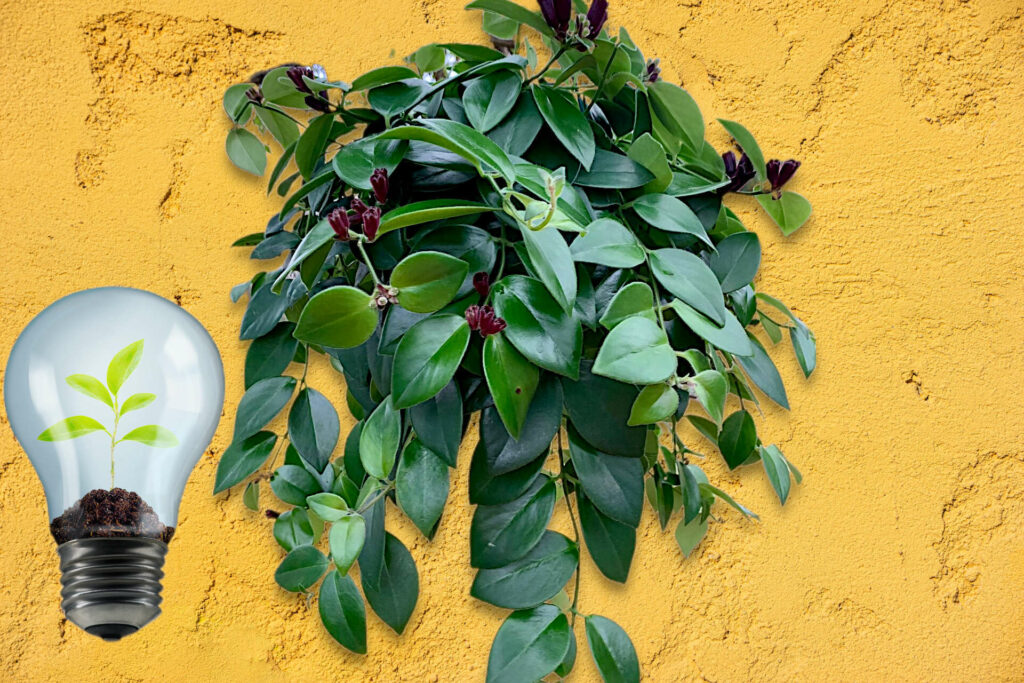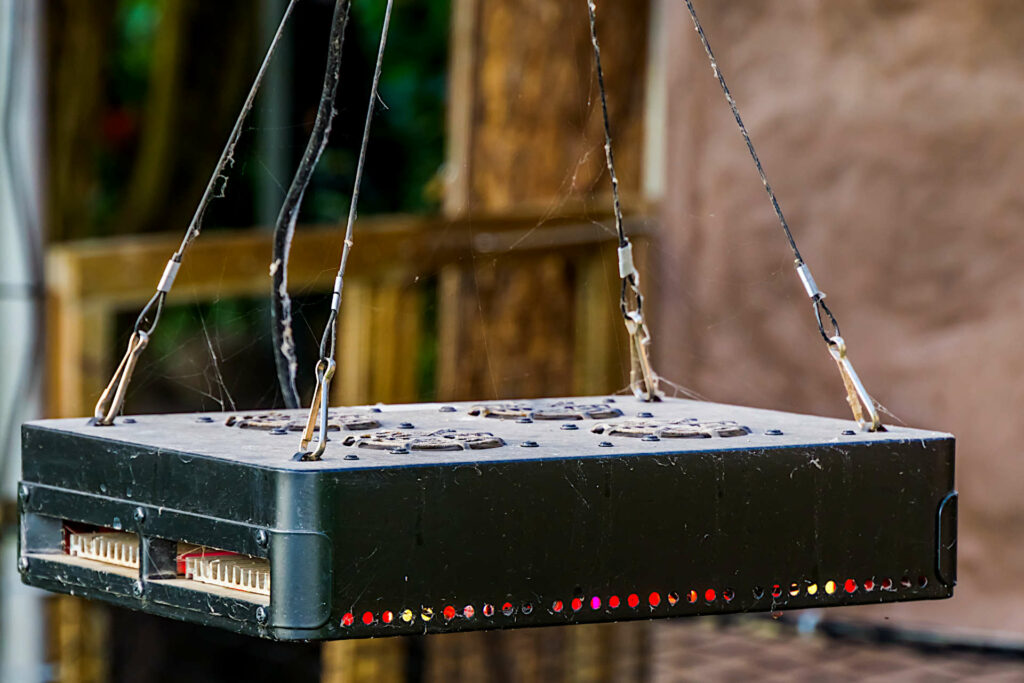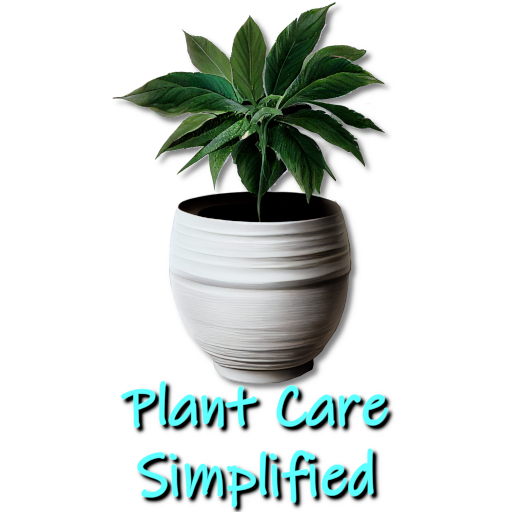Light Requirements For Lipstick Plants
Kim is passionate about helping people create beautiful, healthy indoor spaces that are filled with plants. Kim believes that plants make us happier, healthier human...
Understanding the specific light requirements for lipstick plants (genus Aeschynanthus) is essential in order to achieve optimal growth and vivid flowering of your plant. Prized for their colorful, lipstick-shaped blooms, these houseplants are not too difficult to care for, but irrespective of the varieties of Lipstick plants you have, they do require the correct lighting conditions to thrive properly.
As an epiphytic plant that grows on rainforest trees in its native habitat, the lipstick plant is accustomed to filtered sunlight and consistent humidity. Replicating these conditions by providing the right amount of light is crucial for the plant's health and ability to thrive indoors. This begins with an awareness of the lipstick plant's designation as a moderate light enthusiast that benefits from bright indirect light during the day and cooler darkness at night.
Below we will look at how to create the correct conditions with both natural and artificial light and also so of the issues that point to lighting problems. At the end of the article, you should be able to successfully balance lighting and shade will allow the lipstick plant's foliage to fully develop while coaxing the mesmerizing blooms this plant is loved for.
Understanding Light Requirements for Lipstick Plants

When it comes to indoor plant care, providing the proper lighting is essential for healthy growth. This is especially true for lipstick plants, which have specific light requirements that enable them to thrive.
As a tropical foliage plant native to Asian rainforests, the lipstick plant is accustomed to warm, humid, and brightly lit conditions. In its natural epiphytic form, it grows on the branches and trunks of larger forest trees. This allows the plant to receive filtered sunlight through the rainforest canopy, creating an ambient bright indirect light environment.
Recreating these lighting conditions is key for successfully growing lipstick plants indoors. The plant prefers medium indirect light but can adapt to lower light areas. However, insufficient illumination leads to leggy and weak growth as the plant reaches for light. On the other end of the spectrum, direct hot sunlight will scorch the plant's foliage and cause leaf burn.
When assessing your lipstick plant's light exposure, here are some key factors to consider:
- Indirect Bright Light: North or east-facing windows provide the most ideal exposure without intense direct sun. Sheer curtains can help filter harsh light.
- Avoid Direct Sunlight: Protect plants from direct sun exposure, especially during peak midday hours. Southwest windows typically have the harshest direct sun.
- Supplemental Lighting: If natural light is inadequate, utilize supplemental grow lights to provide extra illumination. LED plant lights can closely mimic the plant's light needs.
- Rotate Periodically: Turn the plant occasionally for even lighting distribution and to prevent stretching toward the light from one direction.
By observing these guidelines for proper lighting conditions, your lipstick plant will be able to photosynthesize optimally. This allows it to put out lush, vibrant new foliage and delightful flowers in return.
Optimal Light Conditions
When cultivating lipstick plants indoors, it is important to provide optimal light conditions to support healthy growth and flowering. The key is replicating the ambient bright, filtered light of the lipstick plant's tropical rainforest habitat.
Indirect Bright Light
Lipstick plants thrive in indirect bright light, meaning they prefer strong illumination without direct sun exposure. A north or east-facing window is ideal, providing gentle morning sun. Sheer curtains can help filter intense midday light from an east window.
Bright indirect light enables efficient photosynthesis, allowing the lipstick plant to produce lush green foliage. Leaves may develop vivid red undersides in higher light. The plant will also bloom reliably when receiving consistent bright light during the day.
Filtered Light
In its native Southeast Asian rainforests, the lipstick plant grows as an epiphyte attached to tree trunks and branches. This habitat provides a naturally filtered light environment as sunlight passes through the rainforest canopy.
Indoors, sheer curtains can mimic this dappled light effect. Positioning plants behind lighter window treatments scatters direct sunbeams and creates ambient illumination. This prevents leaf scorch while still providing adequate light intensity.
Avoid Direct Sunlight
While appreciating bright light, lipstick plants should be protected from prolonged direct sunlight. Intense midday sun will burn delicate leaves, causing yellowing, browning, or scorched spots. Sensitive blooms may also fade or shrivel.
If sunlight is unavoidable, limit exposure to early morning rays at most. Filter sunlight by hanging a lightweight sheer curtain. Also, monitor for signs of stress like leaf curling and reposition plants to avoid the afternoon sun.
By supplying bright but indirect illumination and avoiding direct sunlight, you can satisfy the lipstick plant's light needs for robust growth and spectacular flowering.
Sources of Light for Lipstick Plants
When growing lipstick plants as houseplants, there are two main options for providing the required lighting - natural and artificial light sources. Both can effectively satisfy the plant's needs when used properly.
Natural Light
Utilizing natural light is often the first choice for indoor gardeners. Placing the lipstick plant near a suitable window takes advantage of readily available sunlight.
North or east-facing windows are ideal for delivering the bright, indirect light lipstick plants prefer without intense direct sun. Where light is limited, consider a supplementary grow light to boost illumination.
With consistent exposure to natural light during the day, lipstick plants will flourish with vibrant foliage and prolific blooms. Turn or rotate plants periodically for even lighting on all sides. Monitor for any signs of light stress, like scorching or leaf curling.
Benefits of natural light:
- Free, widely accessible light source
- Provides full light spectrum plants need
- Allows for seasonal variations in daylight
- Promotes natural growth cycles and blooming
Artificial Lighting

For areas without sufficient natural light, artificial grow lights can simulate the rainforest conditions lipstick plants thrive. Modern LED plant lights are an excellent option.
LEDs use full spectrum bulbs to emit light wavelengths beneficial for plant growth. Look for white LEDs (4000-5000K) coupled with red (660nm) and blue (450nm) lighting. Hang LED panels above plants or use directional bulbs.
Run lights for 12-14 hours per day. Use a timer to maintain the right photoperiod and turn off lights at night. Position lights 6-12 inches above the foliage.
Advantages of LED grow lights:
- Deliver usable light wavelengths
- Emit minimal heat
- Customizable and adjustable system
- Energy-efficient operation
- Long-lasting bulbs
With a consistent daily lighting schedule, artificial lights can promote lush, healthy growth and vivid blooms. Monitor plants and adjust duration or intensity if needed.
Common Light-related Issues and Remedies
While lipstick plants thrive in bright, filtered light, incorrect lighting can lead to several issues. Being aware of potential problems and their solutions will help provide optimal conditions.
Leggy Growth
If a lipstick plant is struggling to reach for light, it may start displaying leggy growth, with weak, spaced-out leaf pairs along a spindly stem. This lanky appearance signals that light levels are too low.
To remedy this, move the plant to a brighter location with more direct exposure. Rotate periodically for even lighting distribution. Pruning leggy stems back to a healthy leaf pair will encourage bushier regrowth.
Lack of Flowering
Inadequate light exposure can also prevent lipstick plant blooms. These plants flower in response to a consistent day/night cycle with 12+ hours of bright light and 10-12 hours of uninterrupted darkness.
Ensuring the plant receives enough illumination during its photoperiod encourages buds and blooms. Night interruption from artificial lights also inhibits flowering.
Leaf Discoloration
While lipstick plants don't prefer direct sun, exposure to intense midday rays can still cause leaf scorching. This manifests as yellow or brown spots, yellowed leaf margins, or overall paling of foliage.
Protect plants by filtering harsh sunlight with a sheer curtain. In addition, relocate plants out of the afternoon sun paths or to a shadier spot until any damaged leaves can be trimmed off.
Fungal Issues
In low light and humidity, lipstick plants are prone to powdery mildew and other fungal diseases. Ensure adequate air movement and light exposure to allow leaves to dry out. Remove affected leaves promptly to prevent spreading.
Observing light-related signals and adjusting as needed allows you to maintain optimal conditions for lush, vigorous lipstick plants.
Final Thoughts: Light Requirements For Lipstick Plants
Providing the right lighting conditions is crucial for growing vibrant, healthy lipstick plants indoors. By understanding the plant's light requirements and replicating its natural rainforest habitat, you can achieve optimal results.
The lipstick plant thrives in bright, filtered light similar to that filtered through the rainforest canopy. Aim for ambient indoor lighting by placing the plant near an east or north window filtered with a sheer curtain. Avoid intense direct sun, which can damage delicate leaves and blooms.
Supplement with LED grow lights if natural light is inadequate. Use full spectrum bulbs to provide light wavelengths that fuel photosynthesis and growth. Maintain a consistent daily photoperiod as well.
With the proper light exposure, lipstick plants will flourish with lush foliage tinged in red. Prolific dangling flower spikes will add charming pendants of color. Rotate plants periodically for even lighting distribution and check for signs of light stress.
While the care needs of Lipstick plants are moderate in their needs, they do require careful attention to lighting for health and beauty. By supplying bright, indirect illumination, you can recreate the rainforest environment and enjoy this alluring plant in an indoor environment. Its dazzling flowers will reward you richly for providing the light levels it desires.
Videos
Resources
University of Missouri -D. Trinklein: Lighting Indoor Houseplants
Kim is passionate about helping people create beautiful, healthy indoor spaces that are filled with plants. Kim believes that plants make us happier, healthier human beings, and she loves sharing her knowledge with others so they can experience the joys of plant care for themselves. <a href="https://plantcaresimplified.com/kim-marson/">Read more</a>
More Posts